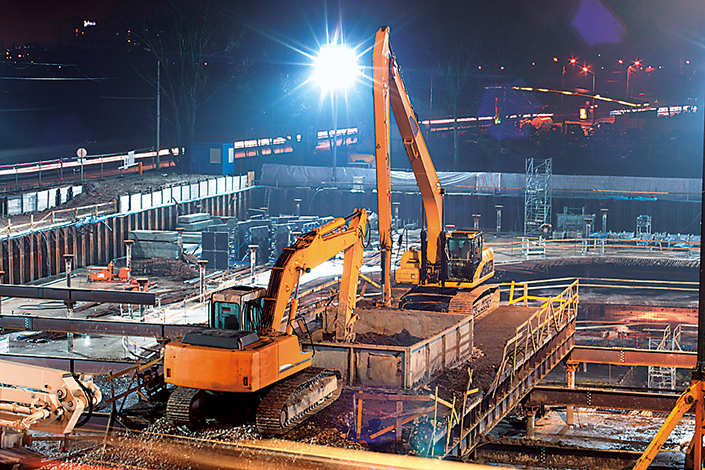Lighting of construction sites
Contents |
[edit] Introduction
In order that construction work can continue effectively and safely in periods of insufficient natural light, it is important that a site is fitted with suitable artificial lighting. Lighting can be used internally for general movement and working on the site itself, externally for illuminating entry, storage and circulation areas, and can also be an effective form of deterrent for trespassers.
There are a wide range of lamps available, from simple tungsten filament lamps to tungsten halogen and discharge lamps. Site lighting is generally run off mains electricity at a voltage of 230 V, rather than through the use of generators. Sometimes it can be necessary to reduce the voltage to 110 V.
[edit] Lighting plan
For an appropriate lighting plan to be drawn up, the types of activity that will be likely to require lighting need to be specified. These activities can then be given an illumination target (with the unit being lux). Lamps are often given a measurement in lumens (lm), which is the total quantity of visible light emitted. One lux is one lumen per square metre.
Examples of recommended minimum target values for building activities include:
External lighting:
- Circulation: 10 lx
- Materials handling: 10 lx
Internal lighting:
- Circulation: 5 lx
- Working areas: 15 lx
- Concreting: 50 lx
- Carpentry and joinery: 100 lx
- Bricklaying and plastering: 100 lx
- Painting and decorating: 200 lx
- Site offices: 200 lx
- Drawing board positions: 300 lx
While manufacturers will often specify the best arrangement for lamps according to required use, it is common practice to plan for at least twice the recommended target values. This is because lamps in use can be subject to deterioration, dirt or other conditions that reduce their performance.
It is possible to calculate the required lumens for a particular need with the following equation:
Total lumens required = area to be illuminated (m2) x target value (lx) / Utilisation factor
Where the utilisation factor is 0.23.
Once the lamp type has been chosen, the required number can be calculated with the following equation:
No. of lamps required = total lumens required / lumen output of lamp
[edit] Site arrangement
Lighting can be arranged on site in a static formation, where lamps are fixed to support poles, masts or items of plant such as scaffolding and tower cranes, or, it can be arranged locally, as and where work is progressing, by the use of moveable supports or being hand-held with trailing leads.
Walkways are often illuminated by bulkhead lamps on standard mains voltage. Bulkhead lamps have a die-cast aluminium alloy body together with a vandal-resistant translucent polycarbonate diffuser.
To illuminate general working areas, festoon (overhead) lighting can be suspended from grids at regular spacings. These are usually tungsten filament bulbs, and both cable and lampholders must be appropriately weather-resistant.
The arrangement must be such that visual intrusion and light spillage are kept to a minimum, particularly in close proximity to residential properties and busy roads where it may cause nuisance or distraction. Where necessary, lighting should be provided to site boundaries to ensure the safety of passing pedestrians.
For more information, see How to work safely on a construction site in the dark.
[edit] Related articles on Designing Buildings Wiki
- BREEAM Reduction of night time light pollution.
- Colour Rendering Index CRI.
- Construction phase plan.
- Daylight factor.
- Daylight lighting systems.
- Ergonomics in construction.
- General lighting v task lighting.
- How to work safely on a construction site in the dark.
- Improving visibility and resilience of buried services.
- Health and safety.
- Light obstruction notice.
- Light pollution.
- Lighting.
- Pre-construction information.
- Rights to light.
- Site appraisal.
- Site information.
- Site layout plan for construction
- Site plan.
- Site facilities.
- Site office.
- Site safety.
- Site storage.
- Site survey.
- Temporary site services.
- Welfare facilities.
[edit] External references
- ‘Building Construction Handbook’ (6th ed.), CHUDLEY, R., GREENO, R., Butterworth-Heinemann (2007)
Featured articles and news
Latest Build UK Building Safety Regime explainer published
Key elements in one short, now updated document.
UKGBC launch the UK Climate Resilience Roadmap
First guidance of its kind on direct climate impacts for the built environment and how it can adapt.
CLC Health, Safety and Wellbeing Strategy 2025
Launched by the Minister for Industry to look at fatalities on site, improving mental health and other issues.
One of the most impressive Victorian architects. Book review.
Common Assessment Standard now with building safety
New CAS update now includes mandatory building safety questions.
RTPI leader to become new CIOB Chief Executive Officer
Dr Victoria Hills MRTPI, FICE to take over after Caroline Gumble’s departure.
Social and affordable housing, a long term plan for delivery
The “Delivering a Decade of Renewal for Social and Affordable Housing” strategy sets out future path.
A change to adoptive architecture
Effects of global weather warming on architectural detailing, material choice and human interaction.
The proposed publicly owned and backed subsidiary of Homes England, to facilitate new homes.
How big is the problem and what can we do to mitigate the effects?
Overheating guidance and tools for building designers
A number of cool guides to help with the heat.
The UK's Modern Industrial Strategy: A 10 year plan
Previous consultation criticism, current key elements and general support with some persisting reservations.
Building Safety Regulator reforms
New roles, new staff and a new fast track service pave the way for a single construction regulator.
Architectural Technologist CPDs and Communications
CIAT CPD… and how you can do it!
Cooling centres and cool spaces
Managing extreme heat in cities by directing the public to places for heat stress relief and water sources.
Winter gardens: A brief history and warm variations
Extending the season with glass in different forms and terms.
Restoring Great Yarmouth's Winter Gardens
Transforming one of the least sustainable constructions imaginable.
























Comments